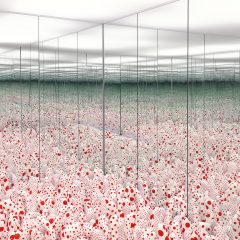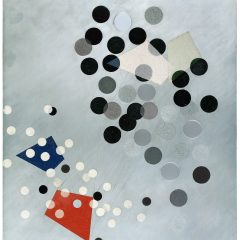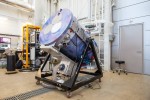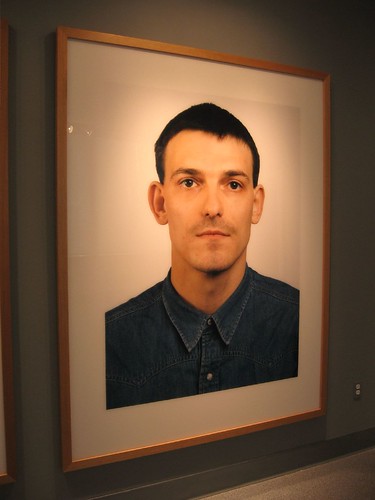
Thomas Ruff, Portrait (Thomas M. Schell), 1987, C-print, 210.8 x 160 cm
“Hot” is what Gabe Martinez promised, trying to get Roberta and me to the photography exhibit Through You. And he’s right. It’s hot not just because it’s from steamy Miami.
This the second big photography exhibit to come here from Miami to a college art gallery. Through You, at the University of Pennsylvania, is from the Martin Z. Margulies collection, widely acknowledged as one of the top collections in the country (I can’t find who ranked it, alas). (The previous Miami big photo collection exhibit, from Dennis Scholl, was at Moore College. See posts here, here and here.)
Through You exhibits 23 masters of photography showing 56 works, at the Charles Addams Fine Arts Gallery. In the nearby hallway is some student work reflecting the influence of these photographers; this youthful work also is worth a look. The two shows are up through Oct. 24.
The photographers deliver a multi-faceted essay on reality and unreality, subverting and manipulating the documentary voice of photography for their own purposes.
Although the exhibit has a mix of familiar and unfamiliar work, it still delivers surprises in how the photos talk to each other. The exhibit also serves as a reminder that photography is always asking questions about what’s real and what it means to see something framed through a glass lens.
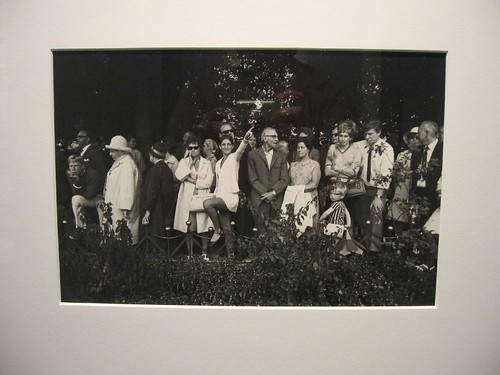
Garry Winogrand, New York City (Woman Behind Rope Pointing), 1970s
gelatin silver print, 27.9 x 35.6 cm
The conversation among the photos is sometimes formal: A Garry Winogrand crowd line-up shot talks to an Andreas Gursky crowd shot across the way and to a William Eggleston crowd shot nearby.
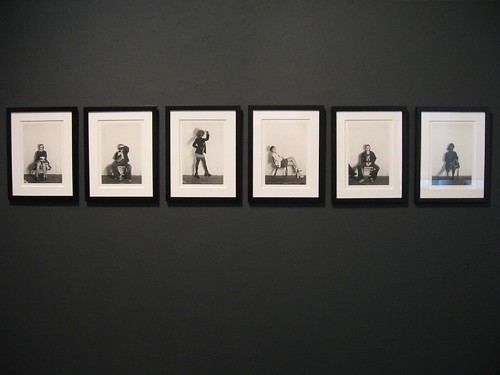
Cindy Sherman,
untitled, #374, 371, 375, 377, 363 and 368, 1976/2000
each a black and white photograph, 25.4 x 20.3 cm
The content also is in conversation: Cindy Sherman’s untitled (Bus Riders series–rarely exhibited) , with Sherman posing in black face in some of them, is a cough away from Andres Serrano’s hooded Ku Klux Klanner, as well as Serrano’s laughing, very dark-skinned African American incongruously dressed in Klan gear; Christian Boltanski’s anonymous portraits behind glass or plastic several inches thick have a conversation with the opacity of Thomas Ruff’s deadpan shots of his college friends, and with Shizuka Yokomizo‘s peeping Tom portraits of people taken through their front windows.
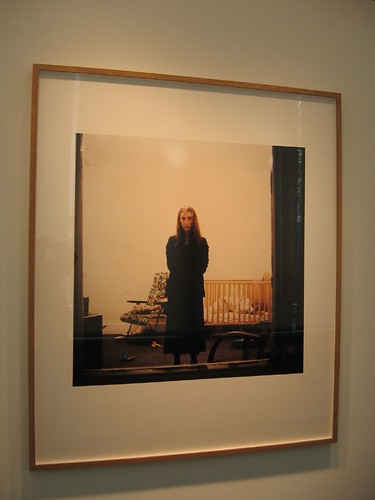
Shizuka Yokomizo, Stranger (14), 2000
C-print, 127 x 108 cm (framed)
These last works were the among my favorites. Yokomizo, avoiding any personal contact, asks people via an anonymous note in the mailbox if they will pose for her, standing still at their front windows at a given time, while she, out in the street, with no personal contact, takes slow-exposure photographs of them. The subjects sign the request and return it as a written contract. In the photographs, the subjects eyes try to focus on what’s happening, try to look into the night to see who’s out there and what she is doing.
Yokomizo gathers in not just an image of her subject, but a room from their lives. The creepy surveillance appears to break through the window glass divider–and not. The situation is not all that different from the anonymous internet chat room, where people are not quite what they seem as they enter into a contract to communicate on shaky ground without giving their whole selves over to a true relationship.
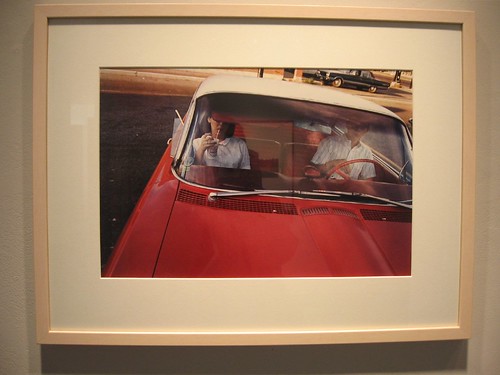
William Eggleston, Untitled (Diner Couple in Car at Drive-in Restaurant, Memphis, TN 1965-68, Dye transfer print, 40.6 x 50.8 cm
This mix of anonymity and surveillance is behind a photo by William Eggleston made in the 1960s. A couple of young people with Micky D’s take-out, partially obscured by the windshield of a cherry red car, look so unhappy and uncomfortable, each pressed against the opposite door in the cushy front seat. This is the most documentary shot in the show, a virtual snapshot of a moment in time.

Lucas Samaras, Set Up 34, 2003, pure pigment on paper, 60 x 57.2 cm, ed. 1/5
Another favorite is a pigment print photo self-portrait (of course!) by Lucas Samaras in which the colors have been altered and heightened so Samaras’ blue face turns him into Pan as he stands over a pond with ducks with hyper-orange beaks and feet. The photograph, in a snow-coated landscape, is pure magic–and pure nonesense, a shameless set-up. It talks to the surreal masked faces of Ralph Eugene Meatyard.
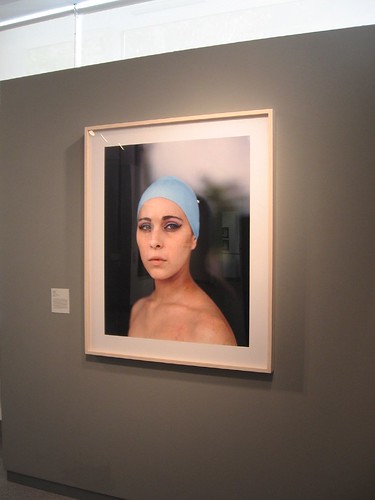
Alec Soth, Misty, 2005, C-print, 101.6 x 81.3 cm
Alec Soth’s stunning portrait, Misty, with its blurred background and Philip-Lorca diCorcia’s Head #3, also with a blurred background, become iconic representations of the cool urban North (diCorcia) and of the more community-driven Southern culture (Soth). The subjects both present themselves to the world with a number of coded choices–Misty her makeup and scarf, Head #3 his leather, earphones, cap and dark glasses, their projected self-images overwhelming the need for detailed backdrops. They are images of time and place–without the place spelled out.

Seydou Keita, images listed clockwise from top left
Untitled (A Malian Patriarch and his Two), 1949-97, Gelatin Silver print, 61 x 50.8 cm;
Untitled (Man in Black Fez), 1949-97, Gelatin Silver print, 61 x 50.8 cm;
Untitled (A Father with his Two Daughters), 1949-97, Gelatin Silver print, 61 x 50.8 cm;
Untitled (Republican Guards in Leave Uniform), 1949-97, Gelatin Silver print, 61 x 50.8 cm
In total contrast are Seydou Keita’s portraits from Bamako, the backdrops of his photo studio as detailed and important as the outfits and the faces, a quilt of texture and pattern and social hierarchy. The outsider photographs of Diane Arbus and Nan Goldin of people creating their own transgressive society offer a wonderful contrast. And so does Thomas Demand, who communicates culture and values and society without a human in sight, by photographing meticulously real-looking set-ups of made of paper.
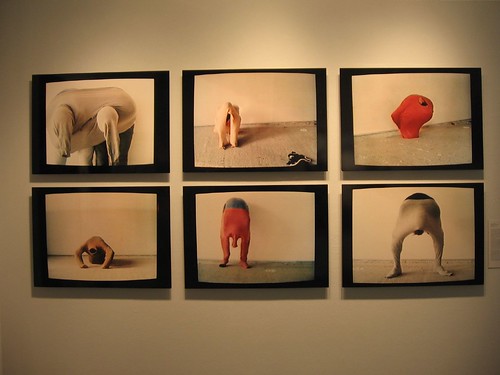
Erwin Wurm, 59 positions, 1992/99, C-prints, each 50 x 70 cm
All this and I haven’t even mentioned sculptor Erwin Wurm’s playful body geometry, conceptual artist John Baldessari’s mischievous eradication of faces in a conventional photo, Tim Hyde’s passing urban scene, Vik Muniz’s witty appropriations reimagined, Sally Mann’s Freudian myth-making from personal relations, Gregory Crewdson’s fiction narratives of life in the balance, and Justin Kurland’s Arcadian fictions, a sort of This Girl’s Life.
All in all, a great show, beautifully curated by a team that included the students choosing the photographers, the faculty and the collection’s curatorial staff choosing the work.
Plus, there’s a great catalog, with essays by the faculty involved and the students, and it’s free!!!!
Speaking of the students, their small show in the hallway includes some outstanding work. Here are some of my favorites:
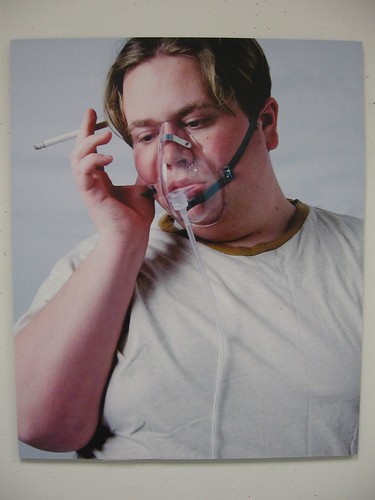
Nick McMahon’s photo, which uses the cool white backdrop of Ruff, for example, and of fashion photography, captures a load of emotion. McMahon manages to overcome the photo’s knee-jerk polemics with the vulnerability of the young man and the beauty of his casual pose and his skin.
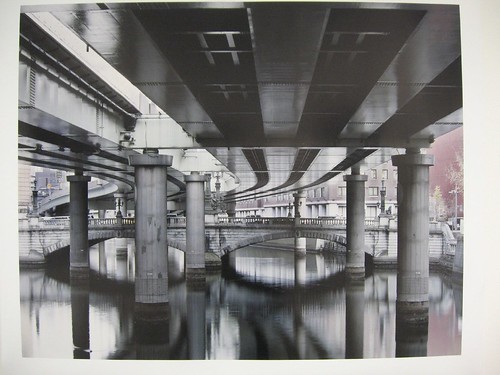
Tetsugo Hyakutake,U of P 2nd year MFA Photography, Untitled, digital print, 2008
The formal beauty of this shot communicates the impersonal qualities of the city and its highways. It reminds me of the shiny cool of Gursky’s large spaces, specifically his Paris Center Pompidou, 1995, which is one of the photos in Through You.
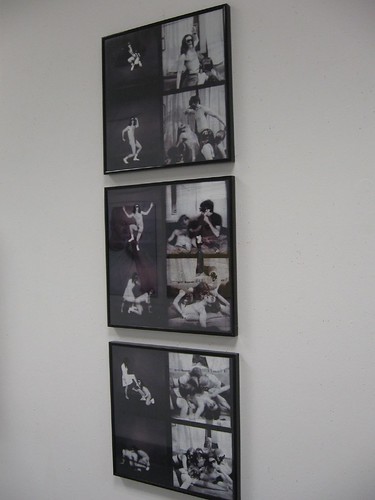
Nick Salvatore, U of P Senior Fine Arts Major in Photography, Rock Star Diaries 1-3, Digital Print 2007
Nick Salvatore mixes the Dionysian exuberance and sexuality of the rock’n’roll world with a good dose of silliness, thereby exposing the powerful commercial quality of most images of the music world.
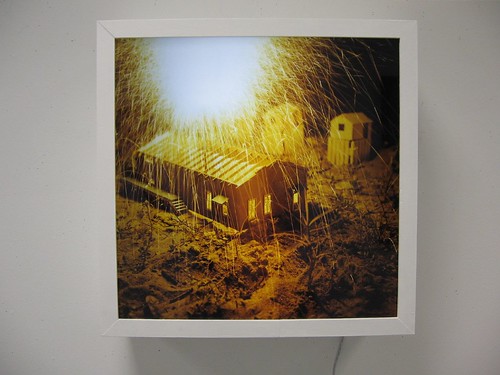
Cecelia Post, U of P 2nd year MFA photography, Natural Won’t Change Disaster, Duratrans on Lightbox, 2008
Toxicity meets Americana in this one. Its hard-headed anti-romanticism is not an easy position to take, these days, when everyone is pretending that eating tofu and granola will save us.
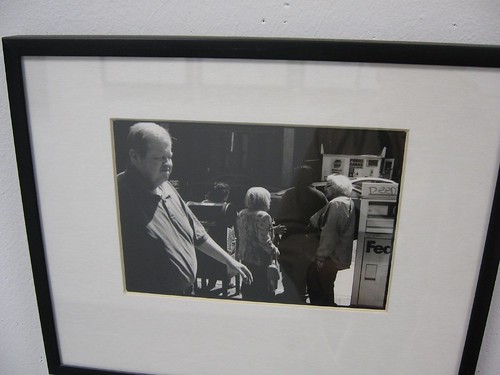
Erik Nielsen, U of P Senior Fine Arts Major in Photography and Painting, untitled, Silver Gelatin Print, 2008
A classic street photo, notable for the ordinariness of the scene–not total grunge, but not glamor, with street furniture having equal weight with people. It’s a lit moment in daily time–and a portrait of what’s real.



